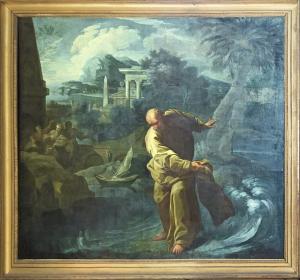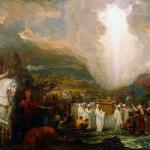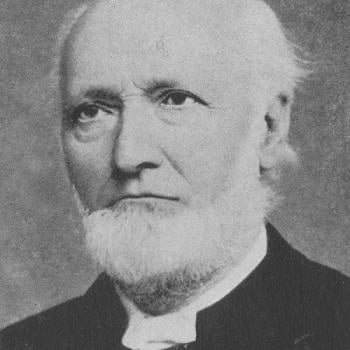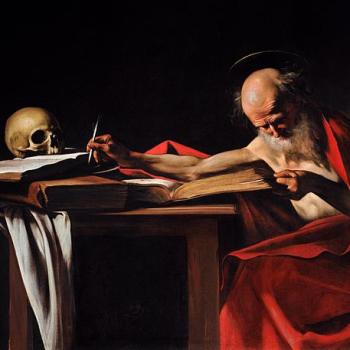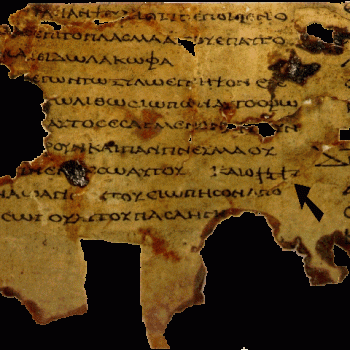François Turretin (1623-1687) was a Genevan-Italian Reformed scholastic theologian and renowned defender of the Calvinistic (Reformed) orthodoxy represented by the Synod of Dort, and was one of the authors of the Helvetic Consensus (1675). He is generally considered to be the best Calvinist apologist besides John Calvin himself. His Institutes of Elenctic Theology (three volumes, Geneva, 1679–1685) used the scholastic method. “Elenctic” means “refuting an argument by proving the falsehood of its conclusion.” Turretin contended against the conflicting Christian perspectives of Catholicism and Arminianism. It was a popular textbook; notably at Princeton Theological Seminary, until it was replaced by Charles Hodge‘s Systematic Theology in the late 19th century. Turretin also greatly influenced the Puritans.
This is a reply to a portion of Institutes of Elenctic Theology (Vol. 2, Eleventh Topic: The Law of God, Eighth Question: The Worship of Relics). I utilize the edition translated by George Musgrave Giger and edited by James T. Dennison, Jr. (Presbyterian and Reformed Publishing Company, Phillipsburg, New Jersey: 1992 / 1994 / 1997; 2320 pages). It uses the KJV for Bible verses. I will use RSV unless otherwise indicated. All installments of this series of replies can be found on my Calvinism & General Protestantism web page, under the category, “Replies to Francois Turretin (1632-1687).” Turretin’s words will be in blue.
*****
Should the bodies of saints and relics be adored with religious worship?
No. They should be venerated, not worshiped, like all holy things. As we have explained till we’re blue in the face (some folks are dense or slow, I reckon), adoration is for God alone.
We deny against the papists
No, he denies against a straw man, not what the “papists” actually believe. You would think that an educated man could get it right. But that’s too much to ask. Where anti-Catholicism is concerned, straw men, ignorant, misguided insults, and non sequiturs rule the day, along with ignoring large portions of the Bible.
Although indeed the Sophists of the present day . . . deny that the adoration due to God is paid to them, but only veneration and honor; still it is certain that it was sanctioned by the authority of the Second Council of Nicea in these words: “Adoring bones, ashes, garments, blood, and sepulchers, still we do not sacrifice to them” (Actione 4, Mansi, 13:47).
Denzinger’s Enchiridion symbolorum is the official source for Catholic dogma. #600-603 in the 2012 edition are from the Second Council of Nicaea in 787. The Definition concerning Sacred Images from Session 8, on October 23rd referred to such images or relics twice as “venerable” (#600, p. 207), and believers are urged “to give them salutation and respectful veneration. This, however, is not actual worship, which, according to our faith, is reserved to the divine nature alone. “Honor[ed]” and “venerates” are both mentioned twice more in this section (#601, p. 207). Further statements of the council from the same day refer to “veneration” (#605, p. 208) and “honor” (#608, p. 208). No adoration or worship seen here.
The older 1955 version (#302; see online on page 121; cf. #306, p. 123) is very similar. #302 states that “to render honorable adoration to them, not however, to grant true latria according to our faith.” Precisely. Why can’t Turretin get it right? There are many more Catholic decrees about it that Turretin could have consulted. Pope John XV wrote in 993 (Encyclical Cum conventus esset), that Catholics
venerate and honor the relics of the martyred and confessors in order that we may venerate him whose martyrs and confessors they are; we honor the servants so that honor may redound to the Lord, who said” Whoever receives you, receives me” [Mt 10:40] . . . (#675, p. 231)
It’s very clear what is going on. Something might be made of the fact that adoramus is the original Latin for “venerate” in this statement. But according to a Latin-English dictionary, the word can mean “reverence, honor, worship, adore.” In other words, it’s just like the Greek and biblical word proskuneo, that is applied both to God in the Bible and also many times to persons. Context determines the meaning, and it’s made very clear in the above statement. There is no usurpation of the Lord’s sole prerogatives; no idolatry or blasphemy. It is believed that the veneration of saints is a form of thanking and worshiping God, by Whose grace they are what they are. Turretin has no case against us.
Pope Martin V in 1418 referred to relics being “venerated” (venerari): #1269, p. 333). This word has a range of meaning, just as adoramus and proskuneo do. So we must go by context and what the Catholic Church decrees as proper belief and practice with regard to relics. Nowhere do we teach that they ought to be adored in place of God, as idols.
The Council of Trent on December 3, 1563, stated that relics are to be venerated and honored (#1822, p. 429; cf. #1867, p. 436), because “Through them many benefits are granted to men by God.” That’s not idolatry. God did many things through St. Paul, for example, that the great evangelist often refers to in his epistles (including “saving” others, many times). Was he trying to make himself an idol, equal to or above God, in so writing? Of course not. What he was saying applies to all saints, especially the following, which perfectly typifies biblical and Hebraic paradox:
1 Corinthians 15:10 But by the grace of God I am what I am, and his grace toward me was not in vain. On the contrary, I worked harder than any of them, though it was not I, but the grace of God which is with me.
Scripture has sanctioned such worship nowhere either by command or promise or example.
Relics has to do with the principles of sacramentalism: grace conveyed by physical things (e.g., water, the Eucharist), and the belief is part and parcel of the reverence that Scripture extends to all holy things. Hence, King David says, “I will worship toward thy holy temple in the fear of thee” (Ps 5:7). The temple is holy, so to worship towards it or in it is a good thing. And it’s holy because of its connection to God, as His special dwelling place on earth: especially in the Holy of Holies at its center (Ex 25:21-22).
The ark of the covenant was so holy it could not be touched, and hence it was transported with poles that ran through rings on its side (Ex 25:13-15). In fact, on one occasion, when it was about to fall over while being moved, after the oxen stumbled, one Uzziah merely reached out to steady it and was immediately struck dead (2 Sam 6:7). Mt. Sinai was holy due to God’s tangible presence there, in the burning bush (Ex 3:5). Just before the Hebrews were to receive the Ten Commandments, God charged the people to not even touch the mountain, or its “border,” on pain of death (19:12-13). Even animals were included in the restriction! God’s special presence – considered apart from the fact that He is also omnipresent – imparts holiness (Deut 7:6).
The New Testament continues to refer to Jerusalem as the “holy city” (Mt 4:5; 27:53 above), and Jesus spoke of the Holy of Holies as “the holy place” (Mt 24:15; cf. Heb 9:2, 12, 25). St. Peter calls the Mount of Transfiguration “the holy mountain” (2 Pet 1:17-18; cf. Mt 17:1-6). Protestants widely use the terms “Holy Bible” and “Holy Land”. In so doing, they tacitly acknowledge the notion of “holy things”: even though, if pressed, they may argue against it, as I once did myself. If something is holy, then it can and should be reverences, including the bodies of holy people who have died.
Someone might agree with all of the above but note that it is not directly pertaining to relics. Well, the Bible has a lot about them, too, which is better understood in light of the above underlying principles. The Bible provides examples of relics having power to heal or bring about other miracles:
2 Kings 13:20-21 So Elisha died, and they buried him. Now bands of Moabites used to invade the land in the spring of the year. And as a man was being buried, lo, a marauding band was seen and the man was cast into the grave of Elisha; and as soon as the man touched the bones of Elisha, he revived, and stood on his feet.
Methodist Adam Clarke, in his Commentary on the above passage, admitted the validity of the principle involved here, even though his subsequent remarks reveal that he doesn’t personally care much for it:
This shows that the prophet did not perform his miracles by any powers of his own, but by the power of God; and he chose to honour his servant, by making even his bones the instrument of another miracle after his death.
2 Kings 2:14 Then he took the mantle of Elijah that had fallen from him, and struck the water, saying, ‘Where is the Lord, the God of Elijah?’ And when he had struck the water, the water was parted to the one side and to the other; and Elisha went over.”
Acts 5:15-16 They even carried out the sick into the streets, and laid them on beds and pallets, that as Peter came by at least his shadow might fall on some of them. The people also gathered from the towns around Jerusalem, bringing the sick and those afflicted with unclean spirits, and they were all healed.
Acts 19:11-12 And God did extraordinary miracles by the hands of Paul, so that handkerchiefs or aprons were carried away from his body to the sick, and diseases left them and the evil spirits came out of them. (cf. Matthew 9:20-22)
Elisha’s bones were what Catholics classify as a “first-class” relic — a relic from the person himself. These passages, on the other hand, offer examples of “second-class” relics — items that have power because they were connected with a holy person (Elijah’s mantle and even St. Peter’s shadow) — and third-class relics, or something that has merely touched a holy person or first-class relic (handkerchiefs that had touched St. Paul).
God said to Moses regarding the body of a lamb offered at the temple: “Whatever touches its flesh shall be holy …” (Leviticus 6:27). So now we again have a dead thing (like Elisha’s bones) imparting holiness. How is that any different from Catholic relics? Likewise, the same was said even of the cereal offering (Leviticus 6:14-18).
Protestant critics of relics will ask where we should draw the line between a proper use of relics and a corrupt, idolatrous one. If they become idols in place of God or are used for financial gain, or are thought to be magic charms (superstition), that’s wrong, and the line has been crossed. The understanding of them has to be sacramental and incarnational, and grounded in a proper biblical understanding of the veneration of saints.
Superstition and idolatry are — like lust or pride or greed — erroneous and wicked attitudes that reside in someone’s heart. We don’t usually know if this is what they are thinking simply by observing outward actions. Two people could be bowing before a relic. One is in fact (if we knew their inner attitude) viewing it as a charm or an idol, and is gravely sinning. The other is venerating it, which is perfectly biblical and Catholic. So the lines are difficult to determine, based on these inherently subjective factors. It’s not a simple matter.
If God wanted human beings to bow before and pray to God and worship Him before inanimate objects such as the ark of the covenant and the temple, because it was thought that holy things gave special power and efficacy to prayers, how much more should we venerate bodies of saints?:
Joshua 7:6 Then Joshua rent his clothes, and fell to the earth upon his face before the ark of the LORD until the evening, . . .
1 Chronicles 16:4 Moreover he appointed certain of the Levites as ministers before the ark of the LORD, to invoke, to thank, and to praise the LORD, the God of Israel. (cf. Deut 10:8)
2 Chronicles 7:3 When all the children of Israel saw the fire come down and the glory of the LORD upon the temple, they bowed down with their faces to the earth on the pavement, and worshiped and gave thanks to the LORD, saying, “For he is good, for his steadfast love endures for ever.”
Psalm 138:2 I bow down toward thy holy temple and give thanks to thy name for thy steadfast love and thy faithfulness; for thou hast exalted above everything thy name and thy word.
King Solomon prayed before the sacred altar: both standing and kneeling (1 Ki 8:22-23; cf. 8:54 [kneeling]; 2 Chr 6:12-14; the Jews swore oaths by the altar in the temple: 2 Chr 6:22). The prophet Daniel prayed to and thanked God in the direction of Jerusalem, three times a day, even from Babylon (Dan 6:10; cf. 1 Ki 8:44, 48; 2 Chr 6:20-21, 26-27, 29-30, 32-34, 38). Levites talked to God before the ark as well (Dt 10:8; cf. 1 Ki 3:15; 8:5; 1 Chr 16:4; 2 Chr 5:6). So how — in light of all of the above — can there possibly be an objection to praying in conjunction with relics?
The principle is precisely the same as what we have in the Bible, as far as I can see. Jesus exhibited the same sacramental principle, in using His saliva to heal someone, and by His robe healing a woman, or telling the blind man to go wash in the Pool of Siloam (after which he could see). He took a girl by the hand before He raised her from the dead (Mt 9:25), and touched blind people’s eyes before healing them (Mt 20:34), and touched a person’s hand before healing a fever (Mk 1:31), and touched an ear before healing it (Lk 22:51). The question is: why did Jesus do that when all He had to do was declare a healing? He did so because it was one of many examples of the sacramental principle behind relics.
And what He said about the woman being healed by touching “the fringe of his garment” (Lk 8:44) is remarkable with regard to relics. He referred to “some one” who “touched me” twice (Lk 8:45-46), and Luke reiterates that “she had touched him” (Lk 8:47). But literally speaking, she had not touched “Him” at all. She merely touched “the fringe of his garment”. Therefore, Jesus was equating His power with His own garment, and in a certain qualified sense, even Himself with it, in saying, “I perceive that power has gone forth from me” (Lk 8:46). The power went out from Him, through His garment, to the woman, and caused her to be healed. This is the Catholic doctrine of second-class relics, right from the mouth of Jesus.
It was the same with the apostles:
Acts 5:12 Now many signs and wonders were done among the people by the hands of the apostles. . . .
Acts 19:6 And when Paul had laid his hands upon them, the Holy Spirit came on them; and they spoke with tongues and prophesied.
Acts 19:11 And God did extraordinary miracles by the hands of Paul,
Protestants will, furthermore, object to pilgrimages to relics in order to have more meritorious and efficacious prayer. This is little different from all the Israelite pilgrimages to Jerusalem for the feast days and to offer sacrifice in the temple. Holy places and holy things in the Bible have power, and this power can transfer in some supernatural way to Christians. Protestants object that paying a lot of money to do so is improper.
But I counter-reply that we shouldn’t object to a pious Catholic (now or in the Middle Ages) paying a lot of money to make a pilgrimage to a holy place, including seeing and venerating relics (it cost a lot of money for me to go to Israel), when we have no objection whatsoever to folks going on expensive vacations on yachts, or flying all around the world, spending multiple thousands of dollars (not to mention a host of other arguably materialistic things). If we can go see the wonders of nature or man’s architectural masterpieces, why is it immediately thought to be a “problem” if someone pays money to go on a religious pilgrimage?
Even Martin Luther (who started the Protestant movement) advocated the goodness and propriety of relics after his 95 Theses (October 1517) and even after the pivotal and famous (or infamous) Diet of Worms (January-May 1521):
[W]e ought to encase the bones of saints in silver; this is good and proper. (Sermons I, ed. and tr. John W. Doberstein; Sermon on the Man Born Blind, 17 March 1518; in Luther’s Works, vol. 51)
Many make pilgrimages to Rome and to other holy places to see the robe of Christ, the bones of the martyrs, and the places and remains of the saints, which we certainly do not condemn. (Explanations of the Ninety-Five Theses, Aug. 1518; tr. Carl W. Folkemer; in Luther’s Works, vol. 31)
These many years your Grace has been acquiring relics in every land; but God has now heard your Grace’s request and has sent your Grace, without cost or trouble, a whole cross, with nails, spears and scourges. I say again, grace and joy from God on the acquisition of the new relic! (To the Elector Frederic of Saxony, end of Feb. 1522; in Luther’s Correspondence and Other Contemporary Letters, Vol. II: 1521-1530; translated and edited by Preserved Smith and Charles M. Jacobs [Philadelphia: The Lutheran Publication Society: 1918] )
Luther’s 95 Theses never even mentioned relics, which makes sense, since he wrote all three of the above statements after the time of the 95 Theses.
A Protestant might object that people in the Bible didn’t collect and venerate bones; they simply buried people. But of course, a proper burial is honoring a person, and visiting gravesites (as every Protestant has done) is not wholly unlike giving homage to holy persons and saints and making pilgrimages to their gravesites or relics connected with them. This is nowhere more evident than in the extreme reverence that Jews to this day give to gravesites of their heroes of the faith. I observed this firsthand in Israel in 2014 at Rachel’s tomb and King David’s. These are very holy places, and they are acting just as their ancestors did.
Protestants object that human beings tend to become idolaters, including of relics. The solution to that is to reform hearts and transform souls by the power of God, prayer, grace, and conversion of heart. The answer is not to eliminate every practice — including relics — that might lead to idolatry in such people. Lots of people make the Bible an idol, or find doctrines in it that simply aren’t there. Does that mean we get rid of the Bible, which arguably “caused” all the false doctrines floating around? No, we correct and educate such people and push them in the right direction.
It’s no different in Protestantism. Sola fide (faith alone) is sadly all too often corrupted into antinomianism. Love of the Bible becomes bibliolatry or a radical Bible Alone position. Private judgment devolves into rampant sectarianism and denominationalism. The various denominations don’t teach these things, but they are rampant “on the ground”: just as Protestants complain about Catholicism and relics. We don’t throw the baby out with the bathwater. We reform the practice and foster a right understanding of the essential meaning underneath and behind it.
As often as in the Old or New Testament the examples of the dead are commemorated, their bodies are said to have been committed to the earth without any ostentation or religious veneration. Thus dying Jacob and Joseph ordered their bones to be carried out of Egypt to Canaan that they might rest with their fathers; but nowhere do we read that they were adored or kissed, nor were they placed in a tabernacle or carried about in processions or placed upon altars (all which are constantly practiced in the Roman church).
That’s right. But we do read about God commanding manna (a second-class relic of God Himself, so to speak) to be kept:
Exodus 16:32-34 And Moses said, “This is what the LORD has commanded: `Let an omer of it be kept throughout your generations, that they may see the bread with which I fed you in the wilderness, when I brought you out of the land of Egypt.’” [33] And Moses said to Aaron, “Take a jar, and put an omer of manna in it, and place it before the LORD, to be kept throughout your generations.” [34] As the LORD commanded Moses, so Aaron placed it before the testimony, to be kept.
Why? What was the purpose? Why wasn’t the written biblical record enough? Why did God also command Moses to keep Aaron’s staff (Num 17:10), to also be kept in the ark? That was a second-class relic of Aaron. Both, along with the tablets of the Ten Commandments (a second-class relic of Moses, and written by the finger of God: Ex 31:18; Deut 4:13; 10:1-4), were kept in the ark of the covenant (Deut 10:2, 5; Heb 9:4), which we have seen was regarded as a great aid in prayer, praise, petitions to God, and the holiest item in the Jewish religion, just as the Wailing Wall is today, because it was connected with the temple; and they pray there as a result and believe that the prayers will be especially efficacious. I was honored and privileged to do the same.
Imagine, all of this is in the Bible, and yet the learned Turretin, blissfully ignorant, stupidly asserts: “Scripture has sanctioned such worship [what we say is, rather, veneration] nowhere either by command or promise or example.”
And how could the Israelites be induced to kiss or carry about relics when (according to the law of Moses) he was considered polluted who had only touched a corpse.
Well, Turretin needs to answer this himself, since God commanded the Israelites to carry around and venerate His own relics; things directed connected with and caused by Him (manna that He sent — Ex 16:29; Deut 8:3, 16; Ps 78:24; Jn 6:31 — and the tablets of the Ten Commandments that He wrote on).
God himself is said to have buried and concealed the body of Moses (Dt. 34:6) in order that the Israelites might not abuse the relics of so great a man to idolatry.
Really? Who “said” this? It’s not in the Bible that I can find. If not, it’s merely a bald unsubstantiated surmise or speculation of Turretin, that has no authority and is irrelevant to the present dispute. But I am making biblical arguments, not just pulling thoughts out of a hat like a rabbit. But assume for a moment that God did do it for that reason. Why, then, wouldn’t He do that with anyone else? Joseph’s and Jacob’s bones were carried from Egypt. Why didn’t God take them and bury them secretly, for the same supposed reason that Turretin makes a wild guess about? King David was buried, so was Rachel. I visited their tombs in Israel. We know where Abraham was buried (in Hebron). Their bones could have been improperly venerated (from the Protestant perspective), just as Moses’ bones may have been.
It is very consistent with this that there was no other cause of the contest between Michael and Satan (mentioned in Jd. 9) than that Satan
wished to draw forth the dead body of Moses, which Michael wished to conceal and keep hidden.
More groundless thoughts of Turretin’s overactive imagination . . . Jude 9 no more supports his interpretation than Deuteronomy 34:6 does. Neither says a single thing about this supposed reason of God’s.
Christ rebukes “the Pharisees and scribes, hypocrites, because ye build tombs of the prophets, and garnish the sepulchres of the righteous”
(Mt. 23:29) in the meantime despising their doctrines. No less are they to be censured who worship and venerate their dead bodies lying in sepulchers.
This is a truly dumb and clueless argument. Context plainly proves that this statement from Jesus had nothing whatsoever to do with relics. It had an entirely different target and meaning:
Matthew 23:29-32 “Woe to you, scribes and Pharisees, hypocrites! for you build the tombs of the prophets and adorn the monuments of the righteous, [30] saying, ‘If we had lived in the days of our fathers, we would not have taken part with them in shedding the blood of the prophets.’ [31] Thus you witness against yourselves, that you are sons of those who murdered the prophets. [32] Fill up, then, the measure of your fathers.
It’s nothing new for anti-Catholics to utterly ignore even the immediate context of a Bible passage, in their rush to mock and “disprove” Catholicism. It happens all the time. This is an absolutely classic example of it.
The miracle divinely performed at the bones of Elisha (2 K. 13:21) confirmed the faith of his preceding prophecy concerning the coming
irruption of the Moabites, but does not favor the religious worship of his body.
The miracles shows that the presuppositional Catholic principle is correct: holy things, including the bodies of holy people, carry spiritual and potentially miraculous power. From this it follows that they can and should be venerated, the basis of which has already been abundantly shown above. All Turretin has are his own hostile man-made traditions, which are neither biblical nor in accord with the development of the doctrine throughout Church history.
*
*****
*
Practical Matters: Perhaps some of my 4,500+ free online articles (the most comprehensive “one-stop” Catholic apologetics site) or fifty-five books have helped you (by God’s grace) to decide to become Catholic or to return to the Church, or better understand some doctrines and why we believe them.
Or you may believe my work is worthy to support for the purpose of apologetics and evangelism in general. If so, please seriously consider a much-needed financial contribution. I’m always in need of more funds: especially monthly support. “The laborer is worthy of his wages” (1 Tim 5:18, NKJV). 1 December 2021 was my 20th anniversary as a full-time Catholic apologist, and February 2022 marked the 25th anniversary of my blog.
PayPal donations are the easiest: just send to my email address: [email protected]. Here’s also a second page to get to PayPal. You’ll see the term “Catholic Used Book Service”, which is my old side-business. To learn about the different methods of contributing (including Zelle), see my page: About Catholic Apologist Dave Armstrong / Donation Information. Thanks a million from the bottom of my heart!
*
***
Photo credit: Elisha dividing the waters of Jordan with Elijah’s mantle, by Jean-Baptiste Despax (1710-1773) [Wikimedia Commons / Creative Commons Attribution-Share Alike 4.0 International license]
Summary: As part of my series of replies to Calvinist expositor Francois Turretin, I address the communion of saints, particularly relics, which are quite biblically based.


